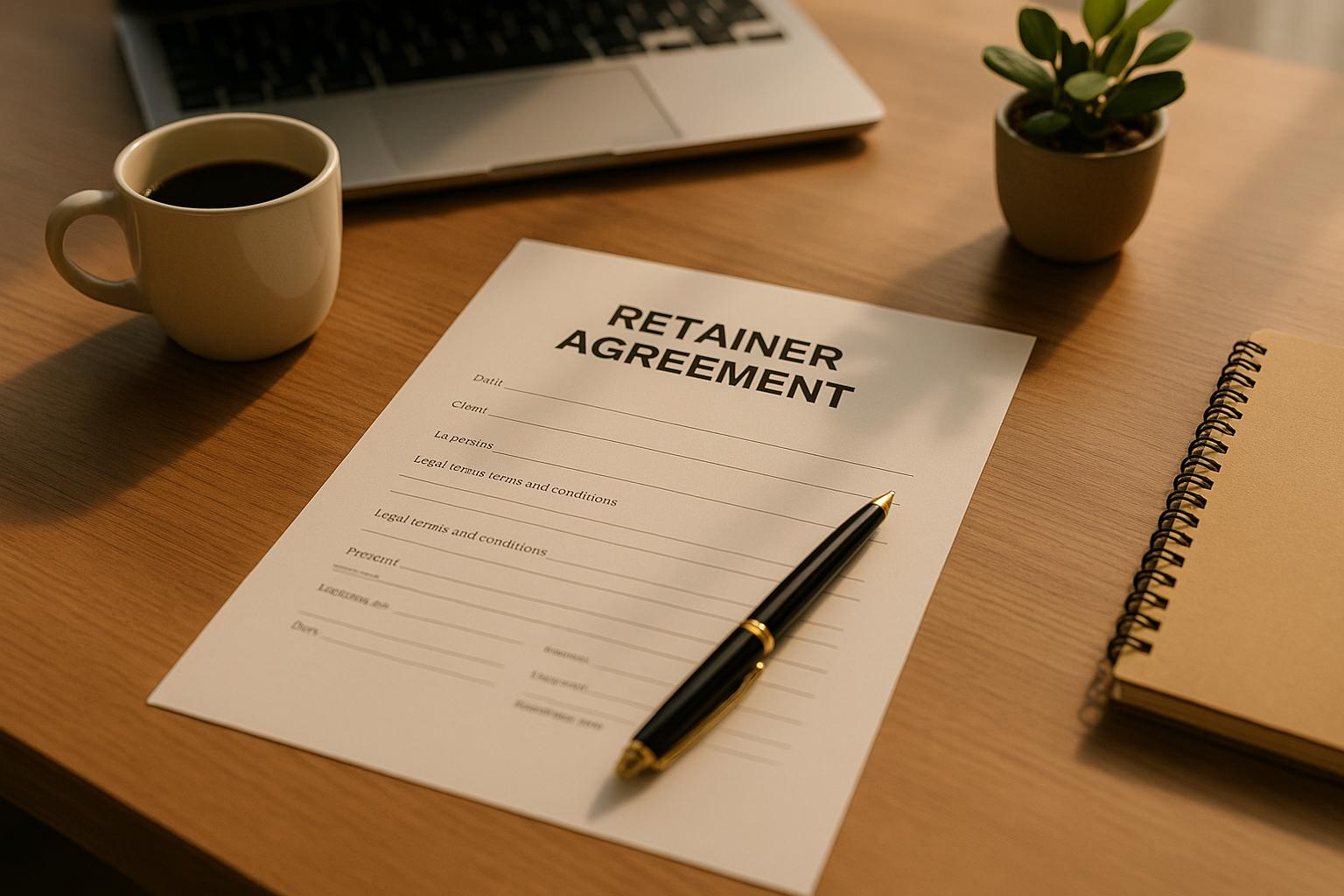A retainer agreement is a critical document that outlines your legal relationship with your attorney, including services, costs, timelines, and responsibilities. Here’s a quick guide to reviewing it effectively:
-
Check Services Provided
- Confirm what legal services are included (e.g., case type, negotiations, court representation).
- Look for exclusions like unrelated legal matters or additional costs for expert witnesses.
-
Understand Costs and Payment Terms
- Review fee structures (e.g., contingency percentages, additional expenses like court fees or medical records).
- Clarify refund policies and how costs are handled if your case doesn’t succeed.
-
Review Timelines and Termination Terms
- Know when representation starts and ends, response times, and cancellation rules.
- Understand your responsibilities if you or your attorney terminate the agreement.
-
Set Communication Expectations
- Confirm how updates will be shared (e.g., email, phone) and response times.
- Check for confidentiality measures and secure document-sharing policies.
-
Clarify Unclear Terms
- Ask questions about fee structures, legal terms, and obligations.
- Get written clarifications for anything unclear to avoid future misunderstandings.
Key Tip: Always take time to fully understand the agreement before signing. If needed, ask your attorney for a detailed explanation of any unclear clauses.
Step 1: Check What Services Are Covered
Start by understanding exactly what legal services are included in your agreement. This step helps set clear expectations and avoids confusion down the line.
Review Case Types Listed
Your retainer agreement should specify the exact types of personal injury cases it covers. Pay attention to details like:
- The type of case (e.g., auto accident, slip-and-fall)
- Whether it includes settlement negotiations and court representation
- Specific legal documents and filings that are part of the agreement
- Whether the services align with your case’s requirements
"At Ocala Injury Law, we believe that every client deserves personalized attention and dedicated advocacy." – Ocala Injury Law
Look for Service Limitations
Once you know what’s included, check for exclusions that could impact your case.
Common Exclusions
- Legal matters unrelated to your personal injury case
- Services requiring outside specialists or expert witnesses
- Administrative costs that may be billed separately
- Legal work after the initial resolution of your case
Special Situations
- Whether multiple legal actions are included under the same agreement
- If negotiations with insurance companies are covered
- Whether medical record collection and review are part of the services
- If post-settlement services are included
Key Steps to Verify
- Get written clarification for anything unclear
- Confirm if additional services can be added and ensure verbal promises are documented
- Ask how services outside the agreement’s scope will be handled
A clear understanding of the services covered ensures both you and your attorney are on the same page. If you spot any gaps between your case needs and the listed services, address them before signing the agreement.
Step 2: Examine Costs and Payment Details
It’s crucial to fully understand the financial terms of your retainer agreement. This ensures there are no surprises and keeps your legal representation transparent.
Check Fee Types
If your attorney works on a contingency basis, they only get paid if they win your case or secure a settlement. Pay close attention to the fee structure, including:
- The percentage of your settlement the attorney will take
- Changes in percentages at different stages of the case
- Cost differences between winning and losing
- Payment timing and how funds are distributed after a settlement
Also, look out for any additional expenses that might increase your overall costs.
"Ocala Injury Law offers free initial consultations to discuss cases and explore legal options."
Find Extra Costs
Your agreement should clearly outline all additional expenses. These often include:
- Court filing fees
- Costs for preparing and copying documents
- Fees for expert witnesses
- Charges for obtaining medical records
- Deposition-related expenses
- Travel costs tied to your case
Make sure to clarify:
- Whether the law firm advances these costs
- If expenses are deducted before or after calculating the contingency fee
- The timeline for paying these costs
- What happens to these expenses if your case isn’t successful
Additionally, check how refunds and early termination fees are addressed.
Review Refund Rules
Understand how refunds and early termination fees are handled. Specifically, check:
- The process for returning unused advanced costs
- How long refund processing takes
- Any non-refundable fees
- How partial work already completed will be billed
- Whether you’re responsible for costs incurred before termination
Key Financial Questions to Ask
- Are there minimum charges for specific services?
- How often will you receive detailed billing statements?
- What payment methods are accepted?
- How are disputes over charges resolved?
Step 3: Review Time Periods and Ending Terms
When hiring legal representation, it’s not just about costs and services. Reviewing timelines and termination terms ensures you’re protected throughout the process.
Check Time Frames
Understanding the timeline is just as important as understanding the fees. Pay attention to:
- Start date: When does the legal representation officially begin?
- Duration: Will the representation last until your case is resolved, or is there a specific end date?
- Renewal terms: Are there options to extend the agreement if needed?
- Deadlines: What are the key legal action deadlines?
- Response times: How quickly should you expect replies to your inquiries?
Look out for automatic renewal clauses that could extend the agreement without your explicit approval.
Understand Cancellation Rules
The agreement should clearly explain how either party can end the attorney-client relationship.
Notice Requirements
- What kind of notice is required (e.g., written notice) and how it should be delivered
- How much advance notice is needed
- Any specific documentation needed to finalize termination
Financial Details
- Payment responsibilities for work already completed
- How unused retainer funds will be handled
- The timeline for receiving refunds, if applicable
Attorney Withdrawal
- When and how an attorney can withdraw from your case
- Steps for transferring your case files
- How ongoing court deadlines will be managed during the transition
Make sure you fully understand your rights and obligations when it comes to ending the agreement. If anything seems unclear, now is the time to clarify.
"Ocala Injury Law offers free initial consultations to discuss cases and explore legal options."
sbb-itb-68ed374
Step 4: Communication Rules
Setting clear communication guidelines is key to maintaining a strong attorney-client relationship. Your retainer agreement should clearly explain how you and your attorney will stay connected.
How You’ll Stay in Touch
Here are some important communication details to look for:
| Aspect | Details |
|---|---|
| Primary Contact Method | Channels like email, phone, or client portal |
| Emergency Protocol | After-hours contact procedures |
| Update Schedule | How often you’ll receive case updates |
| Response Times | Timeframes for replies to your inquiries |
| Confidentiality | Steps to ensure secure information sharing |
These details help keep you informed and ensure your case proceeds smoothly.
Additional points to consider:
- Email security measures
- Safe ways to exchange documents
- Policies for involving third parties
- Documentation of all communications
"Ocala Injury Law uses secure portals and prompt communication to protect client confidentiality."
Before signing, make sure these protocols align with your needs and discuss any specific concerns with your attorney.
Step 5: Get Help Understanding Terms
After reviewing services, payment details, timelines, and communication protocols, make sure you fully understand every term in your agreement before moving forward.
Legal agreements often include complex language. When going through your retainer agreement, pay close attention to:
- Fee structures and how they’re calculated
- Legal terminology that might be unclear
- Specific obligations and deadlines
- Procedures you’re required to follow
Ask Questions About Unclear Parts
If anything seems confusing, ask for clarification – especially about terms that affect your rights or responsibilities. Attorneys should clearly explain the following:
| Section Type | Key Focus |
|---|---|
| Fee Structure | Payment terms and calculations |
| Legal Terms | Definitions of technical terms |
| Obligations | Actions and deadlines required |
| Procedures | Documentation requirements |
Request Written Clarifications
Make sure to get written explanations for:
- Definitions of legal terms
- Your specific responsibilities
- Payment terms and conditions
- Important deadlines
Having these details in writing ensures you have a reliable reference and helps avoid misunderstandings later.
Confirm Mutual Understanding
Ensure both parties are on the same page by getting written confirmation of all terms, clarifications, and any changes made to the agreement. Consider scheduling a follow-up meeting to finalize and document any updates.
"Ocala Injury Law uses secure portals and prompt communication to protect client confidentiality."
Conclusion: Make an Informed Choice
The steps outlined above offer a straightforward guide to reviewing your retainer agreement. Take the time to carefully read and understand its terms. By focusing on key areas – like services provided, costs, timelines, communication methods, and clarifying any uncertainties – you can confidently decide on your legal representation.
Legal agreements don’t have to feel intimidating. A qualified attorney can help address any questions or concerns you may have about your retainer agreement. At Ocala Injury Law, free initial consultations are available to help you understand your rights and review agreement terms before committing.
| Key Points to Review |
|---|
| Services Provided |
| Cost Details |
| Timeframes |
| Communication Methods |
| Term Clarifications |
"At Ocala Injury Law, we believe that every client deserves personalized attention and dedicated advocacy."
Taking the time to understand your agreement helps set clear expectations and ensures a strong foundation for your legal representation. Reach out to schedule a consultation and address any remaining questions to safeguard your interests.
FAQs
What should I do if I don’t understand certain terms in my retainer agreement?
If you come across legal terms or clauses in your retainer agreement that you don’t fully understand, it’s important to seek clarification before signing. Start by asking your attorney to explain the specific terms or sections in plain language. A good attorney will take the time to ensure you’re comfortable with the agreement and its implications.
If you still have concerns or need a second opinion, consider consulting another legal professional to review the document. Remember, understanding your retainer agreement is crucial for protecting your rights and ensuring clear communication with your attorney throughout your case.
How can I make sure additional services not included in the original retainer agreement are properly documented?
To ensure additional services not covered in the initial retainer agreement are documented, request a written amendment or addendum to the agreement. This document should clearly outline the new services, associated costs, and any updated terms. Both you and your attorney should sign the amendment to make it legally binding.
It’s also a good idea to communicate openly with your attorney about any changes to your needs. By addressing these updates promptly, you can avoid misunderstandings and ensure all services are accurately reflected in your agreement.
How do I terminate a retainer agreement with my attorney?
If you need to terminate a retainer agreement with your attorney, start by reviewing the agreement itself. Look for any specific termination clauses, notice periods, or potential fees associated with ending the relationship. Clear communication is key – notify your attorney in writing, stating your decision to terminate the agreement and the effective date. Be polite and professional in your correspondence.
If you’re unsure about any terms or need further guidance, consulting another legal professional can help ensure the process is handled correctly. Remember, you have the right to end the agreement if you feel it no longer serves your best interests.




